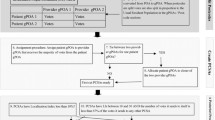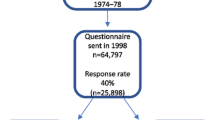Summary
Background
The nine Austrian regions differ according to demographic parameter, health status, and health care structure. It was the aim of this study to analyse whether there are also differences in access points towards the level of ambulatory care.
Method
The Austrian Health Interview Survey (2006–2007) data with 15,474 participants were used for this cross-sectional analysis. Statistical analyses included descriptive statistics as well as multivariate logistic regression models and correlations.
Results
There were significant differences in patients with direct utilisation of specialists without having consulted a general practitioner (GP) in the same period in the Austrian regions, with highest proportions for women in Vorarlberg (20.3 %) and men in Vienna (21.5 %) and lowest in Burgenland (7.0 and 6.6 %, respectively). The specialist/GP ratio correlated significantly with the direct specialist utilisation (Spearman correlation coefficient: 0.717).
Conclusion
There are spatial differences in the health care utilisation within the Austrian regions, which partly can be explained by the disposal of health care structure. These findings are of special importance according to the ongoing debate concerning the topic strengthening the primary health care sector in Austria.
Zusammenfassung
Hintergrund
Die neun österreichischen Bundesländer unterscheiden sich hinsichtlich demographischer Parameter, dem Gesundheitsstatus und der Organisation des Gesundheitsversorgungssystems. Es war das Ziel dieser Studie herauszufinden, ob es auch Unterschiede hinsichtlich der Inanspruchnahme des ambulanten Gesundheitssektors gibt.
Methodik
Für diese Querschnittsanalyse konnte die Datenbank der Österreichischen Gesundheitserhebung 2006–2007 mit Daten von 15.474 TeilnehmerInnen genutzt werden. Die statistische Analyse umfasste deskriptive Methoden, multivariate Regressions-Modelle und Korrelationen.
Ergebnisse
Es konnten signifikante Unterschiede in der Inanspruchnahme von FachärztInnen ohne vorherigen HausärztInnenkontakt gefunden werden. Für Frauen war die Inanspruchnahme am höchsten in Vorarlberg (20,3 %) und für Männer in Wien (21,5 %), am niedrigsten im Burgenland (F 7,0 %, M 6,6 %). Die Facharzt/Hausaztquote des jeweiligen Bundeslandes korrelierte mit der direkten Inanspruchnahme (Spearman Korrelationskoeffizient: 0,717).
Schlussfolgerung
Unterschiede in der Inanspruchnahme des ambulanten Gesundheitssektors können quer durch Österreich gefunden werden, welche zum Teil durch die unterschiedlich organisierte Struktur des Sektors erklärt werden können. Diese Ergebnisse sind von besonderer Relevanz im Hinblick auf die österreichische Diskussion hinsichtlich der Stärkung des Primärversorgungssektors.



Similar content being viewed by others
Notes
It was not possible to build the variable EU28 countries which would be correct since the 1st of July 2013 because of preclustered data in the original database.
References
The World Health Report 2008. Primary health care—now more than ever. Geneva: World Health Organisation; 2008.
Kringos DS, Boerma WG, Bourgueil Y, Cartier T, Hasvold T, Hutchinson A, et al. The European primary care monitor: structure, process and outcome indicators. BMC Fam Pract. 2010;11:81.
Kringos DS, Boerma WG, Hutchinson A, van der Zee J, Groenewegen PP. The breadth of primary care: a systematic literature review of its core dimensions. BMC Health Serv Res. 2010;10:65.
De Maeseneer J, Boeckxstaens P. James Mackenzie Lecture 2011: multimorbidity, goal-oriented care, and equity. Br J Gen Pract. 2012 Jul;62(600):e522–4. Lectures.
De Maeseneer J, Roberts RG, Demarzo M, Heath I, Sewankambo N, Kidd MR, et al. Tackling NCDs: a different approach is needed. Lancet. 2012 May 19;379(9829):1860–1.
Groenewegen PP, Dourgnon P, Gress S, Jurgutis A, Willems S. Strengthening weak primary care systems: steps towards stronger primary care in selected Western and Eastern European countries. Health Policy. 2013 Nov;113(1–2):170–9.
Groenewegen PP. Analyzing European health systems: Europe as a research laboratory. Eur J Public Health. 2013 Apr;23(2):185–6. Editorial comment.
Hoffmann K, Stein KV, Maier M, Rieder A, Dorner TE. Access points to the different levels of health care and demographic predictors in a country without a gatekeeping system. Results of a cross-sectional study from Austria. Eur J Public Health. 2013 Dec;23(6):933–9.
Hofmarcher MM, Oxley H, Rusticelli E. Improved health systems performance through better care coordination. Paris: OEDC; 2007.
Hofmarcher MM, Rack HM. Austria: health system review. Health Syst Transit. 2006;8(3):1–247.
Habl C, Bachner F, Klinser D, Ladurner J. The Austrian health service system. Data and facts. Vienna: Austrian Ministry of Health; 2010.
Habl C, Bachner F. Das österreichische Gesundheitssystem im internationalen Vergleich. Vienna: Austrian Ministry of Health; 2010.
Hofmarcher M, Quentin W. Austria: health system review. Health Syst Transit. 2013;15(7):1–291.
Stigler FL, Starfield B, Sprenger M, Salzer HJ, Campbell SM. Assessing primary care in Austria: room for improvement. Fam Pract. 2013 Apr;30(2):185–9.
Kringos DS. The strength of primary care in Europe. Utrecht: NIVEL; 2012.
World Health Organization, Commission on Social Determinants of Health. Closing the gap in a generation. Health equity through action on the social determinants of health. Geneva: WHO Commission on Social Determinants of Health; 2008.
Macinko J, Starfield B, Shi L. The contribution of primary care systems to health outcomes within Organization for Economic Cooperation and Development (OECD) countries, 1970–1998. Health Serv Res. 2003 Jun;38(3):831–65.
Starfield B, Shi L, Macinko J. Contribution of primary care to health systems and health. Milbank Q. 2005;83(3):457–502.
Starfield B, Shi L. Policy relevant determinants of health: an international perspective. Health Policy. 2002 Jun;60(3):201–18. Comparative Study Research Support, Non-U.S. Gov’t Research Support, U.S. Gov’t, P.H.S.
De Maeseneer J, Boeckxstaens P. Multi-morbidity, goal-oriented care and equity. James Mackenzie lecture 2011. http://www.nivel.nl/pdf/jamesmckenzielecturejandemaeseneer.docx. Accessed 10. Nov 2014.
De Maeseneer JM, De Prins L, Gosset C, Heyerick J. Provider continuity in family medicine: does it make a difference for total health care costs? Ann Fam Med. 2003 Sep-Oct;1(3):144–8.
Friedberg MW, Hussey PS, Schneider EC. Primary care: a critical review of the evidence on quality and costs of health care. Health Aff (Millwood). 2010 May;29(5):766–72.
Doescher MP, Franks P, Saver BG. Is family care associated with reduced health care expenditures? J Fam Pract. 1999 Aug;48(8):608–14.
Delnoij D, Van Merode G, Paulus A, Groenewegen P. Does general practitioner gatekeeping curb health care expenditure? J Health Serv Res Policy. 2000 Jan;5(1):22–6.
Schafer WL, Boerma WG, Kringos DS, De Maeseneer J, Gress S, Heinemann S, et al. QUALICOPC, a multi-country study evaluating quality, costs and equity in primary care. BMC Fam Pract. 2011;12(1):115.
Vedsted P, Olesen F. Are the serious problems in cancer survival partly rooted in gatekeeper principles? An ecologic study. Br J Gen Pract. 2011 Aug;61(589):e508–12. Multicenter Study Research Support, Non-U.S. Gov’t.
Deraas TS, Berntsen GR, Hasvold T, Forde OH. Does long-term care use within primary health care reduce hospital use among older people in Norway? A national five-year population-based observational study. BMC Health Serv Res. 2011;11:287. Research Support, Non-U.S. Gov’t.
De Maeseneer JM, van Driel ML, Green LA, van Weel C. The need for research in primary care. Lancet. 2003 Oct 18;362(9392):1314–9.
Stein KV, Rieder A, Dorner TE. East-West gradient in cardio-vascular mortality in Austria: how much can we explain by following the pattern of risk factors? Int J Health Geogr. 2011;10:59.
Klimont J, Kytir J, Leitner B. Austrian Health Survey 2006/2007. Main results and methodical documentation. Vienna: Statistik Austria; 2007.
Aromaa A, Koponen P, Tafforeau J, Vermeire C. Evaluation of health interview surveys and health examination surveys in the European Union. Eur J Public Health. 2003 Sep;13(3 Suupl):67–72. Comparative Study Evaluation Stud-ies Research Support, Non-U.S. Gov’t.
Stirbu I, Kunst AE, Mielck A, Mackenbach JP. Inequalities in utilisation of general practitioner and specialist services in 9 European countries. BMC Health Serv Res. 2011;11:288. Research Support, Non-U.S. Gov’t.
Starfield B, Shi L, Grover A, Macinko J. The effects of specialist supply on populations’ health: assessing the evidence. Health Aff (Millwood). 2005 Jan-Jun;Suppl Web Exclusives:W5-97-W5-107.
Starfield B, Chang HY, Lemke KW, Weiner JP. Ambulatory specialist use by nonhospitalsed patients in us health plans: correlates and consequences. J Ambul Care Manage. 2009 Jul-Sep;32(3):216–25.
Health in the EU27 in 2010; 60. http://epp.eurostat.ec.europa.eu/cache/ITY_PUBLIC/3-19042012-AP/EN/3-19042012-AP-EN.PDF. Accessed 10. Nov 2014.
OECD StatExtracts. Health expenditure and financing 2009 [database on the Internet]. OECD. 2011. http://stats.oecd.org/#. Accessed 10. Nov 2014.
Peersman W, Pasteels I, Cambier D, De Maeseneer J, Willems S. Validity of self-reported utilisation of physician services: a population study. Eur J Public Health. 2014 Feb;24(1):91–7.
Author information
Authors and Affiliations
Corresponding author
Rights and permissions
About this article
Cite this article
Hoffmann, K., Stein, K. & Dorner, T. Differences in access points to the ambulatory health care system across Austrian federal states. Wien Med Wochenschr 164, 152–159 (2014). https://doi.org/10.1007/s10354-014-0267-z
Received:
Accepted:
Published:
Issue Date:
DOI: https://doi.org/10.1007/s10354-014-0267-z




